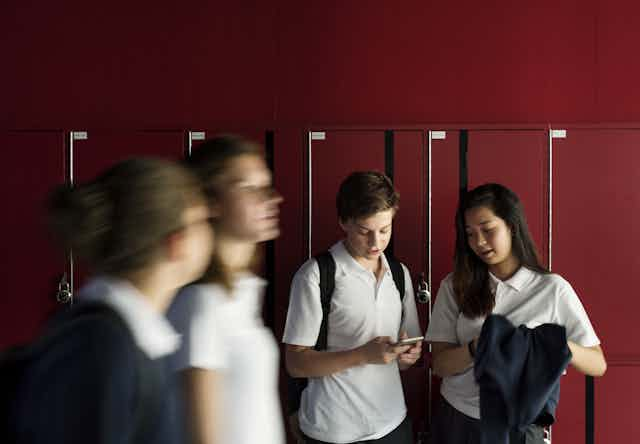This week, one Sydney high school made headlines for banning mobile phones during school hours. Phones can come to school but must stay in locked pouches allowing teachers to “focus on educating students”.
This follows other recent phone bans at both public and private schools around Australia. In 2020, Victoria banned phones for all state primary and secondary schools and many private schools, while prestigious Sydney girls school SCEGGS Darlinghurst banned phones in May 2022.
This is part of a worldwide trend. In a move popular with parents, schools and governments see phone bans as a way to fix bullying and student disengagement.
But research shows banning doesn’t resolve these problems. Instead, we need to educate students about how to manage these problems.
Schools in the firing line
Schools have certainly been thrown into the firing line when it comes to helping young people grapple with technology. Anecdotally, phone bans are supposed to ensure students behave better and pay more attention in class.
However, genuinely resolving issues like these in the long term is not simple. Removing one variable – a phone – cannot address the complexity needed to resolve them.
Read more: Banning mobile phones in schools: beneficial or risky? Here's what the evidence says
The purpose of school is to support children to develop the skills, knowledge and dispositions needed for the era in which they live.
Given we live in a digital era, the question we should be asking is not, “should we ban phones or not”. It should be how can schools support young people to engage with technology in an empowered and positive way? And where does banning mobile phones fit into this?
The research says bans don’t work
From talking to teachers for my work, I know that phones in classrooms can be frustrating. If phones are not silenced or turned over, students can be momentarily distracted if a notification comes up.
But rigorous peer-reviewed research shows banning mobile phones in class have no impact on students’ academic performance. It does not harm or improve academic results in the long-term. A 2020 Swedish study examined high school students grade points (or marks) before and after a year-long mobile phone ban and found no impact.
Despite concerns, research shows mobile phones have generally been found not to disrupt teachers instructing students. This is because students mostly pick them up between tasks or at the end of lessons.
Research also tells us traditional (in-person) bullying continues to be more prevalent than cyberbullying around the world. So, removing one device for six hours a day will not stop bullying.
When thinking about phones in schools, there are three bigger issues we need to think about, beyond simply banning them at the school gate.
1. Living in a distracting world
A 2018 Udemy survey found 36% of millennials and Gen Z employees spend more than two hours checking their smartphones for personal activities during the workday. In real terms, the 40 hour week has turned into a 30 hour work week, plus ten hours on your phone.
So, we know students need to learn how to work and be productive when they are in a technology-immersed world.
This is not to say classrooms should become a free-for-all TikTok fest whenever students feel the urge to go online. But we need to support children to learn how to concentrate and function in a digitally-saturated world.
2. New risks and changes to old ones
The digital era has introduced some risks and changed the nature of others and we need to specifically educate students about these.
Privacy risks have also morphed and follow us almost everywhere we go. Recent research by Internet Study Lab suggests 95% of educational apps used in schools collect personal data about students that is then on sold to third parties.
Students also need to be able to identify misinformation, manage algorithmic bias, understand commercial profiling and watch out for social isolation. And bullying of course now occurs online and follows children beyond the school gate.
Locking phones in pouches may be a short-term solution, but young people will still face these complex, technology-related issues, perhaps as soon as on the way home from school.
3. Treating children with respect
Over COVID lockdowns there was enormous reliance on children to use their devices to learn, socialise and stay mentally well. Now we are (mostly) back to normal and suddenly, young people are no longer to be trusted with a screen in the context of their schooling.
Not only is this confusing for young people, it sets up a dynamic where something they need to use everyday is seen now seen as “wrong” or “harmful”.
Read more: Kids need to learn about cybersecurity, but teachers only have so much time in the day
We need to build trust with young people and empower them with skills and positive habits to use technology well in ways that will enhance their life.
Obviously this adds more pressure and work to already stretched schools, but if phones are going to be banned, they can’t just be ignored in the classroom. There needs to be specific lessons or instruction on the issues around them.
This is no longer a “screentime” conversation. We need new knowledge and new education strategies if children are to thrive online post-COVID and beyond.

